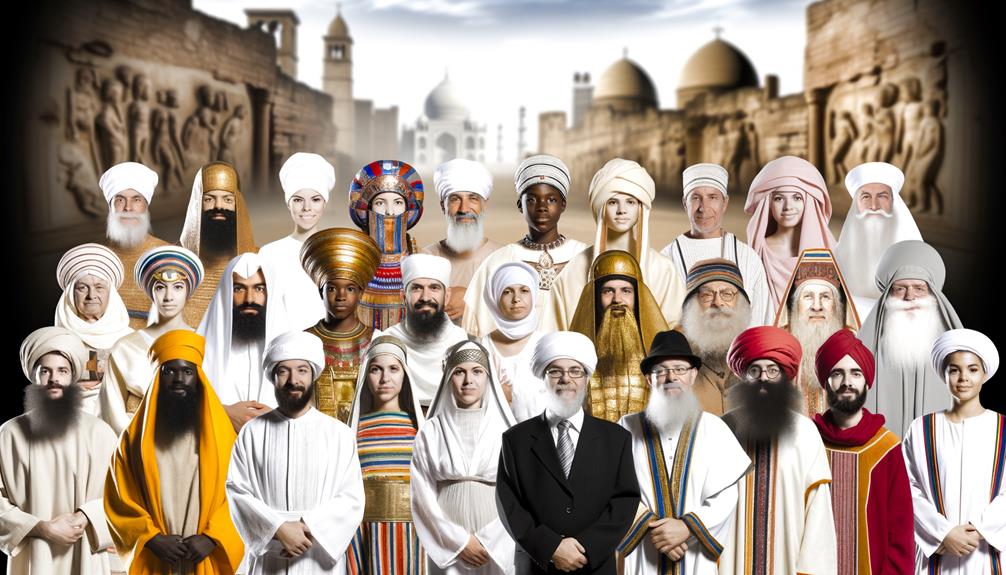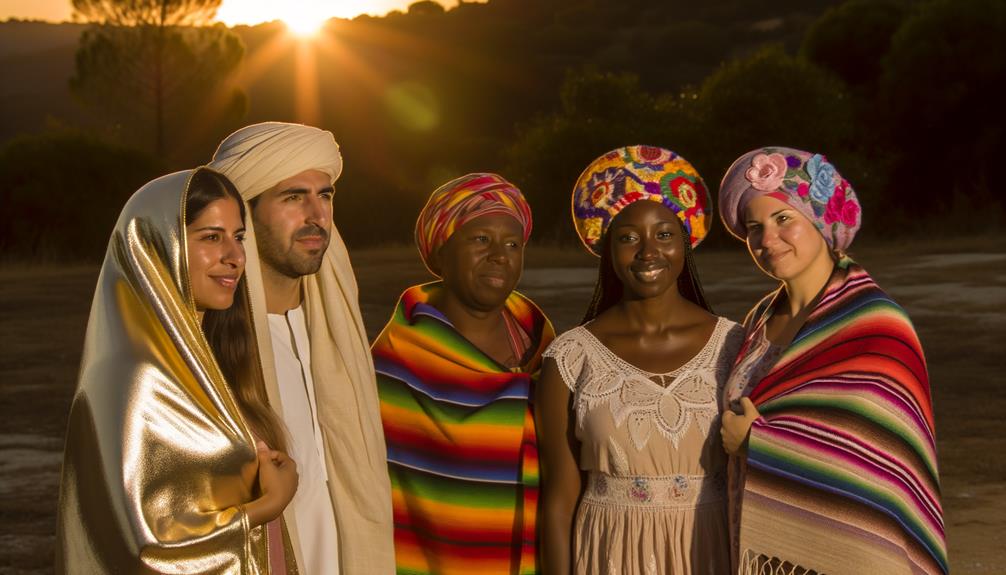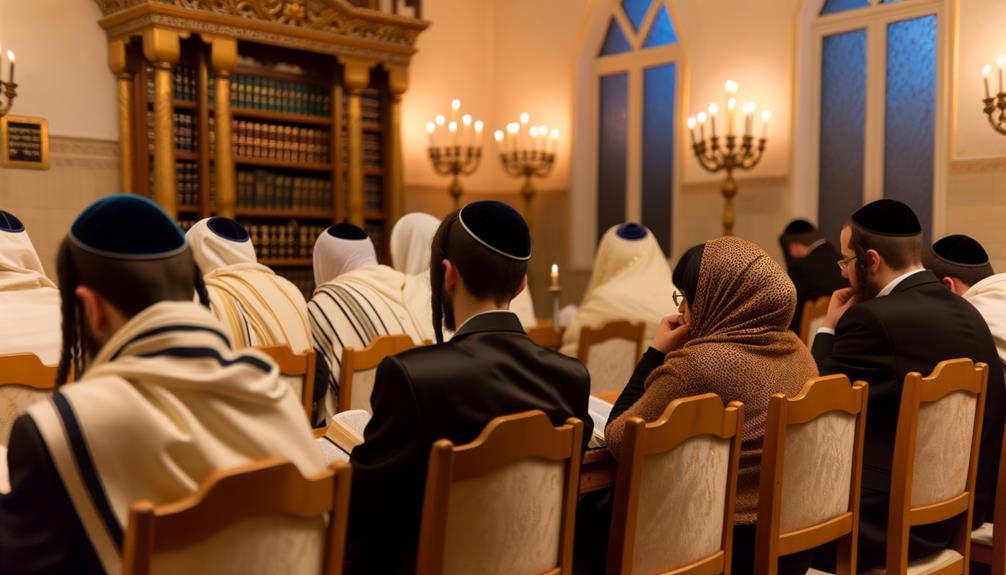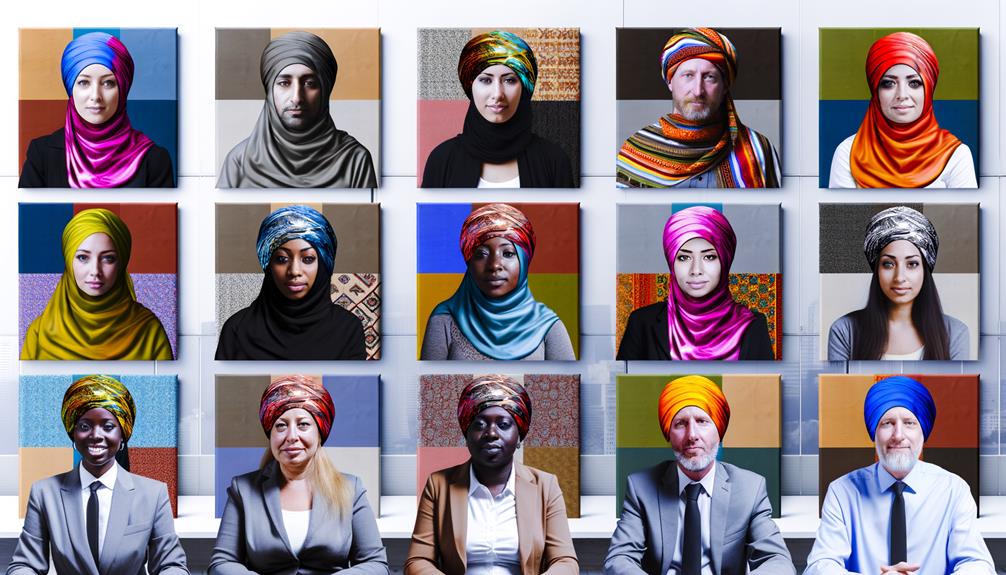Spiritual Meaning of Head Covering: Sacred Protection
The spiritual meaning of head covering emerges as a symbol of reverence, humility, and divine adherence across various cultures and religions. Historically, it signified social status and devotion in civilizations such as Ancient Mesopotamia and Rome.
In Judaism, the kippah demonstrates acknowledgment of a higher power; Christianity upholds head covering for women as a sign of modesty and piety, based on Apostle Paul’s teachings. Islam mandates the hijab to reflect modesty and moral values.
Each tradition infuses unique theological insights into the practice, contending with modern interpretations and societal shifts, revealing thorough cultural and spiritual dimensions. Explore how these nuanced meanings have evolved.

Spiritual Meaning of Head Covering: Protection, Reverence, and Connection
| Practice | Spiritual Meaning | Interpretation |
|---|---|---|
| Covering the Head | Sacred Respect | Sign of reverence in spiritual or religious practice |
| Cloth or Scarf | Energetic Shield | Used to protect spiritual energy and focus inward |
| During Prayer | Divine Connection | Enhances communication with higher powers |
| Cultural Symbolism | Identity & Faith | Reflects spiritual heritage and belief systems |
| Daily Use | Humility | Demonstrates modesty and spiritual mindfulness |
Historical Context

Throughout history, the practice of head covering has frequently held significant spiritual and cultural implications across various civilizations and religious traditions.
In ancient Mesopotamia, head coverings were used to denote social status and devotion to deities. Similarly, in ancient Greece and Rome, veils symbolized modesty and piety among women.
In medieval Europe, head coverings such as coifs and wimples were customary for married women, signifying marital status and religious observance.
Indigenous cultures also embraced head coverings, often as part of ceremonial attire to honor spiritual beliefs and ancestral lineage.
Each of these instances underscores the multifaceted roles head coverings have played, not merely as articles of clothing but as profound expressions of identity, spirituality, and societal norms.
Religious Significance
In numerous religious traditions, head coverings function as a tangible symbol of devotion, humility, and adherence to divine commandments.
In Judaism, the kippah signifies reverence towards God, reflecting an acknowledgment of a higher power.
Similarly, in Christianity, head coverings for women, as mentioned in 1 Corinthians 11:5, represent modesty and respect for divine order.
Islam mandates headscarves like the hijab to maintain modesty and spirituality, as emphasized in the Quran.
Sikhism requires turbans to maintain equality and unity among followers, while Hinduism often sees head coverings during puja as a gesture of respect and purity.
Each tradition employs head coverings to foster a connection with the divine, embedding these practices deeply within their theological frameworks.
Cultural Practices

The cultural practices surrounding head coverings are deeply rooted in historical traditions and imbued with rich symbolism across various societies.
From the hijabs worn by Muslim women to the yarmulkes donned by Jewish men, each culture’s approach to head coverings reflects unique theological interpretations and societal norms.
Exploring these practices reveals not only the diverse ways in which different communities express spirituality but also how head coverings serve as symbols of identity, modesty, and reverence.
Historical Head Covering Traditions
Head coverings have played a significant role in various cultural practices throughout history, often symbolizing religious devotion, social status, and cultural identity.
In ancient Mesopotamia, head coverings were worn by women to signify their marital status and societal rank. Similarly, in ancient Greece and Rome, veils were a mark of respectability and piety among women.
Medieval European Christian traditions mandated head coverings for women during worship, reflecting theological beliefs about humility and reverence.
In Islamic cultures, the hijab emerged as a significant practice, embodying principles of modesty and faith. Meanwhile, in Sikhism, the turban signifies royalty and equality.
These historical contexts underscore the multifaceted importance of head coverings across different eras and societies, shaping identities and spiritual expressions.
Symbolism in Different Cultures
Moving from historical traditions, the symbolism of head coverings in different cultures often intertwines with theological tenets, societal norms, and personal expressions of faith.
In Islam, the hijab represents modesty and obedience to divine commandments, serving as both a spiritual and social statement.
In Sikhism, the turban, or dastaar, is a manifestation of spiritual dedication and equality, reflecting the community’s core values.
Jewish traditions see the kippah as a symbol of reverence and acknowledgment of a higher power.
In Christianity, head coverings like the mantilla or chapel veil are worn during worship, signifying humility before God.
Each culture’s head covering practices are deeply embedded in their religious doctrines and cultural identities, transcending mere fashion to embody profound spiritual significance.
Symbolism in Islam
In Islamic tradition, head covering, particularly for women, encapsulates profound themes of modesty and humility, reflecting a commitment to moral and spiritual values outlined in the Quran.
Historically, it has served as a marker of identity and belonging within the Muslim community, fostering a sense of unity and cultural continuity.
Theologically, the practice symbolizes spiritual dedication, underscoring an individual’s devotion to the tenets of Islam and their relationship with God.
Modesty and Humility
Within Islamic tradition, the practice of head covering, such as wearing the hijab, serves as a profound symbol of modesty and humility, reflecting deep theological principles rooted in religious texts and historical contexts.
The Qur’an and Hadith emphasize modesty as an essential virtue, not merely in dress but in behavior and thought. This modesty is intertwined with humility before God (Allah), reinforcing the believer’s awareness of divine presence and moral accountability.
| Theological Principle | Historical Context | Symbolic Meaning |
|---|---|---|
| Modesty (Haya) | Early Islamic Era | Moral and ethical purity |
| Humility (Tawadu’) | Prophetic Tradition | Submission to Allah |
| Divine Awareness | Quranic Revelation | Spiritual mindfulness |
These elements collectively highlight the hijab’s role in cultivating a pious lifestyle.
Identity and Belonging
The practice of head covering in Islam, such as wearing the hijab, extends beyond personal piety to serve as a powerful emblem of identity and belonging within the Muslim community. It symbolizes a shared commitment to faith and cultural heritage.
Historically, head coverings have delineated social and religious boundaries, fostering a sense of unity among adherents. Theologically, the hijab represents adherence to divine commandments, reinforcing collective identity through observance.
- Historical significance: Tracing back to pre-Islamic traditions.
- Unity in diversity: Embracing cultural variations within the Islamic world.
- Symbol of resistance: Against cultural assimilation and secular pressures.
Understanding these aspects illuminates the profound role of head coverings in fostering a cohesive Muslim identity.
Spiritual Dedication
Expressing spiritual dedication, the practice of head covering in Islam serves as a tangible manifestation of one’s commitment to divine will and religious principles.
Historically, the headscarf, or hijab, emerged as a symbol of modesty and piety in early Islamic society, aligning with Quranic injunctions.
Theologically, it reflects an inner state of humility and reverence towards God, signifying a believer’s intent to adhere to the moral and ethical guidelines set forth in Islamic teachings.
This act of covering is not merely a cultural artifact but a profound declaration of faith, encompassing both personal devotion and communal identity.
Through this practice, individuals articulate their spiritual allegiance and reinforce their continuous journey towards religious fidelity.
Symbolism in Judaism

In Judaism, the act of covering one’s head is imbued with profound spiritual symbolism, rooted in historical context and theological teachings. This practice signifies reverence and humility before God, acknowledging a divine presence that transcends human understanding. The head covering, such as a kippah or yarmulke, serves to remind individuals of their duties and moral obligations under Jewish law.
- Historical Tradition: Originating from ancient customs, head coverings have been worn for centuries as a sign of respect.
- Theological Insight: The Talmud discusses the importance of covering one’s head to instill a sense of awe and humility.
- Cultural Identity: Wearing a head covering helps maintain Jewish identity and continuity.
- Moral Obligation: It acts as a constant reminder of ethical and religious responsibilities.
Symbolism in Christianity
Within Christianity, the tradition of head covering carries deep theological significance, often reflecting themes of modesty, subordination, and reverence in worship practices. Historically, this practice finds its roots in early Christian communities, particularly influenced by the Apostle Paul’s instructions in 1 Corinthians 11:2-16.
Head coverings symbolized a woman’s acknowledgment of authority and divine order, aligning with broader societal norms of the time. Additionally, the veil is seen as an outward expression of inner piety and humility before God. The theological implications extend beyond mere tradition, embodying a visible sign of spiritual truths.
| Theme | Scriptural Reference |
|---|---|
| Modesty | 1 Timothy 2:9 |
| Subordination | 1 Corinthians 11:3 |
| Reverence | 1 Corinthians 11:4-5 |
Modern Interpretations

Amidst evolving cultural dynamics, modern interpretations of head covering within Christianity exhibit a diverse range of theological and practical perspectives, reflecting shifts in societal values and individual expressions of faith.
Some contemporary Christians view head covering as a personal choice rather than a doctrinal mandate, seeing it as an expression of humility and devotion.
Others interpret it symbolically, signifying spiritual authority and submission within the church.
Conversely, a growing number reject head coverings entirely, arguing for gender equality and cultural relevance.
This varied landscape highlights the interplay between tradition and modernity, underscoring the importance of individual conviction.
- Personal choice and expression
- Symbolic representation of spiritual authority
- Rejection based on gender equality
Global Perspectives
Examining head covering practices across various cultures reveals a rich tapestry of historical, theological, and social nuances that shape their significance and application within different Christian communities globally.
In Eastern Orthodox traditions, head coverings are often seen as a symbol of reverence and humility, reflecting deep theological roots.
In contrast, many Western Protestant groups have largely abandoned the practice, viewing it as culturally obsolete.
However, in certain African and Asian Christian communities, head coverings remain a vibrant expression of faith and identity, often intertwined with local customs.
These divergent practices illustrate how interpretations of scripture and cultural contexts influence the spiritual meaning of head coverings, highlighting a dynamic interaction between religious doctrine and cultural expression within the global Christian landscape.
Conclusion
The practice of head covering carries multifaceted meanings across different cultures and religions.
Historically significant and theologically rich, it manifests unique symbolism in Islam, Judaism, and Christianity.
One interesting statistic highlights that 83% of Muslim women in mainly Muslim countries report wearing a headscarf daily, reflecting deep cultural and religious adherence.
Modern interpretations continue to evolve, yet the practice remains a powerful symbol of identity, modesty, and spirituality across the globe.






